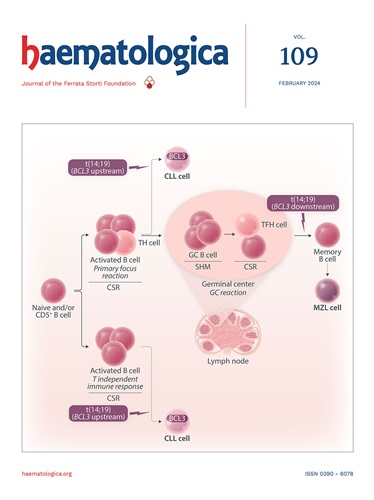Germline and somatic genetic landscape of pediatric myelodysplastic syndromes.
IF 8.2
1区 医学
Q1 HEMATOLOGY
引用次数: 0
Abstract
Pediatric myelodysplastic syndromes (MDS) represent a rare group of clonal hematopoietic stem cell disorders accounting for ~5% of pediatric hematological malignancies. They are characterized by ineffective hematopoiesis, cytopenia, and dysplastic changes in the bone marrow with variable risk of progression to acute myeloid leukemia. Unlike adult MDS, pediatric cases predominantly present with hypocellular bone marrow, with monosomy 7 and trisomy 8 as the most common cytogenetic aberrations. Pediatric MDS can manifest as primary disease or arise secondary to classical inherited bone marrow failure syndromes, prior cytotoxic therapy, or acquired aplastic anemia. In recent years, new germline syndromes have been identified in a substantial proportion of patients with "primary" MDS. The most common are GATA2 deficiency and SAMD9/SAMD9L syndromes, accounting for at least 7% and 8%, respectively. The somatic mutational landscape is different from adult MDS, with recurrent mutations affecting SETBP1, ASXL1, RUNX1, and RAS pathway genes (PTPN11, NRAS, KRAS, CBL), while mutations in spliceosome components and epigenetic regulators which are common in adults, are virtually absent in children. Monosomy 7 serves as a "central hub" in disease evolution, associating with somatic leukemia driver mutations. On the other hand, somatic UBTF-TD and NPM1 mutations define a subtype of MDS with excess blasts with predominantly normal karyotype without known germline predisposition. Hematopoietic stem cell transplantation is the only curative option for pediatric MDS. Understanding the unique genetic profile of pediatric MDS has implications for diagnosis, therapy, donor selection and longterm surveillance, particularly for patients with germline predisposition syndromes. This review discusses current classification systems (WHO and ICC), provides a detailed overview of the germline and somatic genetic landscape of pediatric MDS, and highlights clinical implications of these genetic alterations.小儿骨髓增生异常综合征的种系和体细胞遗传景观。
小儿骨髓增生异常综合征(MDS)是一种罕见的克隆性造血干细胞疾病,约占小儿血液系统恶性肿瘤的5%。它们的特点是造血功能低下、细胞减少和骨髓发育不良,进展为急性髓性白血病的风险不同。与成人MDS不同,儿童病例主要表现为骨髓细胞减少,7号单体和8号三体是最常见的细胞遗传学畸变。小儿MDS可表现为原发性疾病,也可继发于经典遗传性骨髓衰竭综合征、既往细胞毒性治疗或获得性再生障碍性贫血。近年来,在相当比例的“原发性”MDS患者中发现了新的种系综合征。最常见的是GATA2缺乏和SAMD9/SAMD9L综合征,分别至少占7%和8%。体细胞突变图景与成人MDS不同,反复发生的突变影响SETBP1、ASXL1、RUNX1和RAS通路基因(PTPN11、NRAS、KRAS、CBL),而在成人中常见的剪接体成分和表观遗传调节因子的突变在儿童中几乎不存在。7号单体是疾病进化的“中心枢纽”,与体细胞白血病驱动突变有关。另一方面,体细胞UBTF-TD和NPM1突变定义了MDS的一种亚型,其核型主要为正常胚型,没有已知的种系易感性。造血干细胞移植是治疗小儿MDS的唯一选择。了解儿童MDS的独特遗传特征对诊断、治疗、供体选择和长期监测具有重要意义,特别是对有种系易感综合征的患者。这篇综述讨论了当前的分类系统(WHO和ICC),提供了儿科MDS的生殖系和体细胞遗传景观的详细概述,并强调了这些遗传改变的临床意义。
本文章由计算机程序翻译,如有差异,请以英文原文为准。
求助全文
约1分钟内获得全文
求助全文
来源期刊

Haematologica
医学-血液学
CiteScore
14.10
自引率
2.00%
发文量
349
审稿时长
3-6 weeks
期刊介绍:
Haematologica is a journal that publishes articles within the broad field of hematology. It reports on novel findings in basic, clinical, and translational research.
Scope:
The scope of the journal includes reporting novel research results that:
Have a significant impact on understanding normal hematology or the development of hematological diseases.
Are likely to bring important changes to the diagnosis or treatment of hematological diseases.
 求助内容:
求助内容: 应助结果提醒方式:
应助结果提醒方式:


